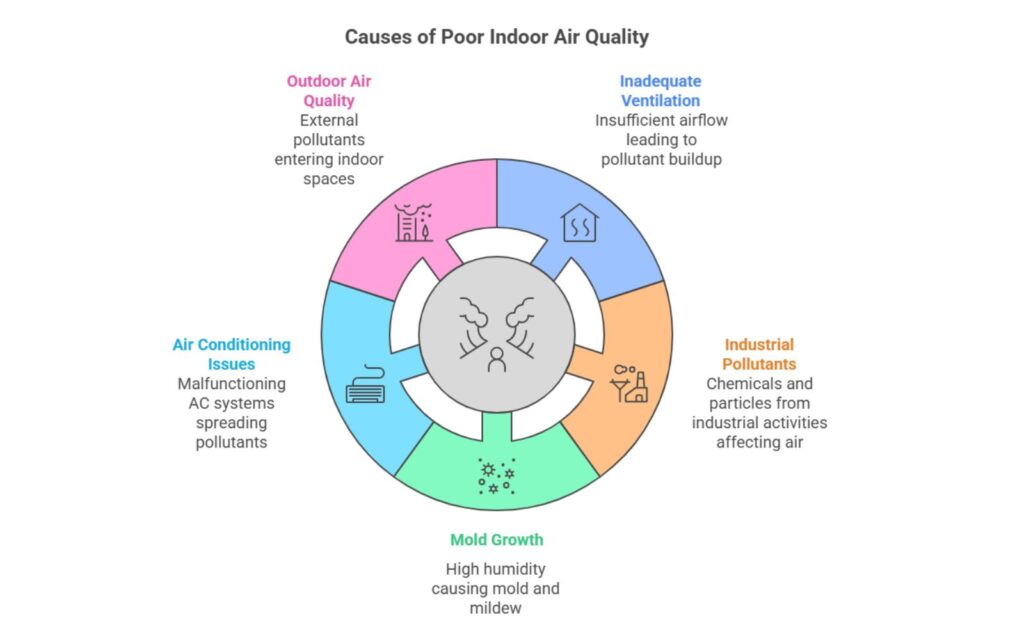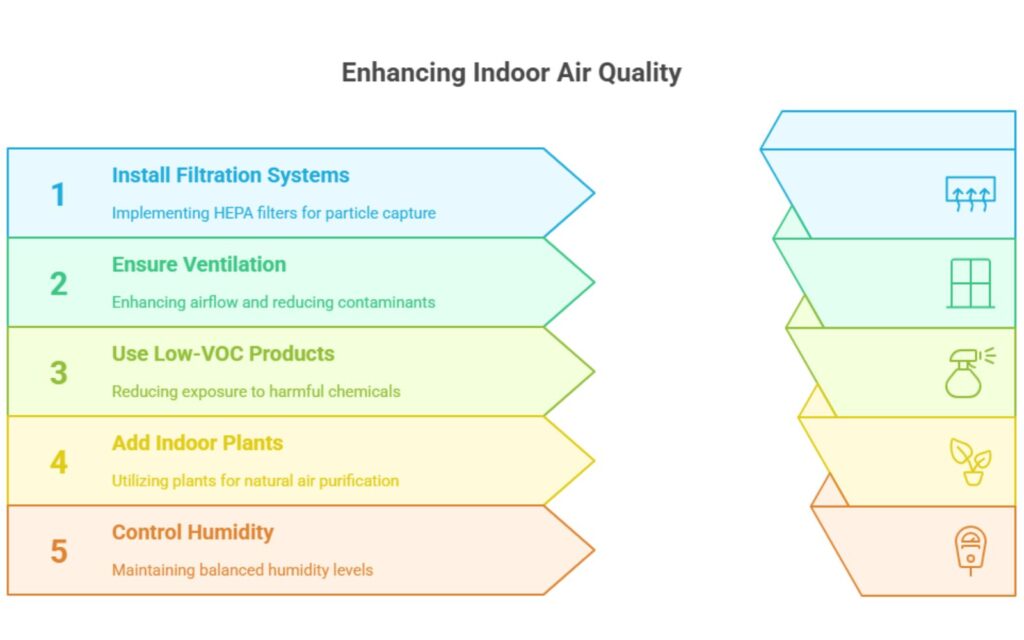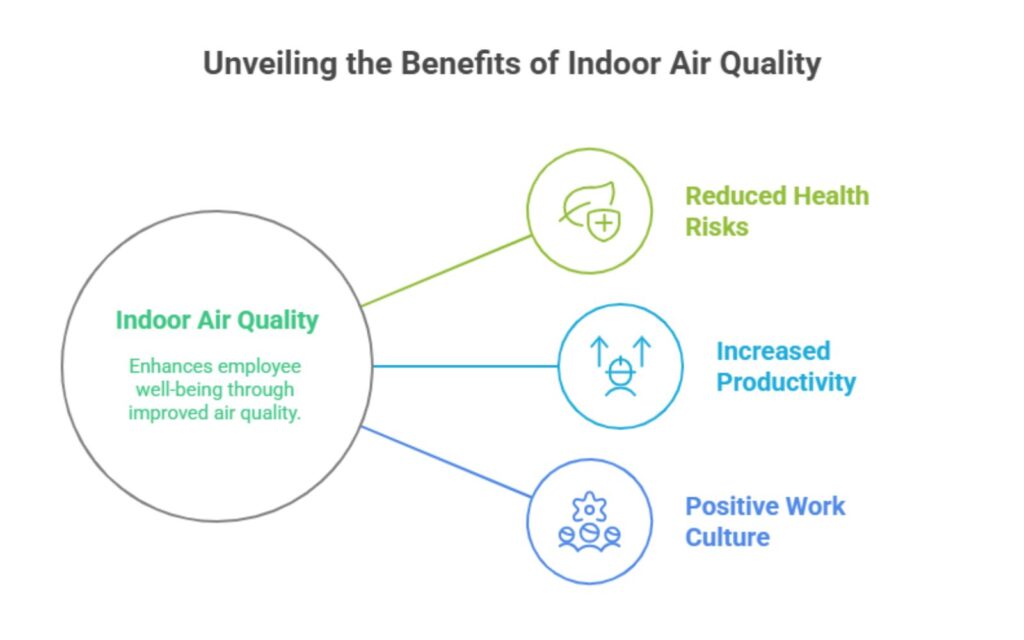Why Indoor Air Quality Matters for Employees

Have you ever noticed how you feel tired, stuffy, or foggy after spending hours in an office? That could be due to poor indoor air quality (IAQ).
While it’s easy to overlook, the air inside our workplaces can be filled with airborne contaminants such as dust, mold, and even volatile organic compounds (VOCs) from cleaning supplies or office furniture.
These air pollutants don’t just make you uncomfortable but can seriously affect your well-being and occupational safety.
In this article, we’ll explore why indoor air quality matters for employees, its impact on employee health, and actionable ways to improve indoor air quality in your workplace environment.
Key Takeaways
- Poor indoor air quality can lead to health risks, including respiratory problems, fatigue, and headaches.
- Indoor air pollution comes from many sources, including cleaning products, industrial processes, and building materials.
- Proper ventilation and regular maintenance of filtration systems can significantly improve air quality.
- Fresh air circulation and addressing humidity levels reduce mold growth and other air quality issues.
The Connection Between Indoor Air Quality and Employee Health

1. Health Risks of Poor Indoor Air Quality
Bad air quality can have both short-term and long-term effects on human health, such as:
- Short-term health issues: Headaches, itchy eyes, and respiratory discomfort.
- Long-term exposure: Asthma, cardiovascular problems, and increased sensitivity to other allergens.
- Exposure to key pollutants, such as carbon dioxide and carbon monoxide, can impair cognitive function and lead to severe health issues.
Without addressing these hazards, indoor environments become breeding grounds for health issues that affect the entire workplace.
2. Indoor Air Quality IAQ and Mental Performance
Air quality matters more than physical health; it also affects mental clarity and productivity.
Studies show that exposure to delicate particulate matter and high CO2 levels can reduce decision-making abilities by up to 50%. In contrast, clean air and proper airflow:
- Boost focus and energy levels.
- Improve mood and reduce fatigue.
- Support better problem-solving skills.
Common Causes of Poor Indoor Air Quality

1. Inadequate Ventilation
One of the primary factors affecting indoor air quality is inadequate ventilation. Without sufficient fresh air circulation, indoor air pollutants accumulate, resulting in unhealthy, stuffy conditions.
2. Indoor Air Pollutants from Industrial Processes and Materials
Specific workplaces are exposed to harmful pollutants due to industrial processes, building materials, and occupational hazards. Common sources include:
- VOC emissions from office furniture, carpets, and paint.
- Airborne contaminants are released during the manufacturing or construction process.
3. Mold Growth and Humidity Levels
Uncontrolled humidity levels create the perfect environment for mold growth. Mold releases spores into the air, triggering asthma, allergies, and respiratory irritation.
4. Air Conditioning and Air Vents
While air conditioning helps maintain a comfortable temperature, dirty air vents can trap dust, dust mites, and other allergens.
If not properly maintained, they circulate these pollutants throughout the office.
5. Outdoor Air Quality
Sometimes, outdoor air contributes to indoor air pollution. Pollutants such as vehicle exhaust and particulate matter from nearby industrial areas can enter through windows or ventilation systems, thereby worsening indoor air quality.
How Poor Air Quality Affects Workplace Productivity

1. More Sick Days and Health-Related Absences
Employees exposed to harmful chemicals and lousy air quality often experience respiratory problems, migraines, and chronic fatigue.
This increases absenteeism, affecting productivity.
2. Lower Engagement and Focus
Without better air quality, employees may struggle to focus due to mental fog and reduced oxygen levels.
This makes everyday tasks feel more exhausting and time-consuming.
3. Reduced Job Satisfaction
An unhealthy work environment impacts morale. Employees who frequently experience discomfort may feel undervalued and unmotivated, which can lead to increased turnover rates.
Steps to Improve Indoor Air Quality

1. Install Advanced Filtration Systems
Filtration systems with HEPA filters capture fine particles like dust, pollen, and bacteria, improving the overall air quality in indoor spaces.
2. Ensure Proper Ventilation
To reduce airborne contaminants, enhance ventilation by:
- Opening windows to allow fresh air to flow.
- Installing ventilation systems that bring in outdoor air while filtering out pollutants.
- Cleaning and inspecting air vents regularly to avoid clogs and dust buildup.
3. Conduct Regular Air Quality Assessments
Routine assessments help identify air quality issues and pollutant levels.
These checks ensure that your office meets air quality standards set by organizations like the National Institute for Occupational Safety and Health.
4. Use Low-VOC Cleaning Products
Use non-toxic cleaning products to reduce exposure to harmful volatile organic compounds.
Schedule cleaning during off-hours to minimize chemical exposure during work hours.
5. Add Indoor Plants for Natural Filtration
Plants such as peace lilies, snake plants, and spider plants serve as natural air purifiers. They absorb toxins and release oxygen, fostering a healthier environment with improved air quality.
6. Control Humidity Levels to Prevent Mold
Maintaining indoor humidity levels between 30-50% helps prevent mold growth. Use humidifiers or dehumidifiers to maintain a balanced air environment, especially during seasonal changes.
7. Replace and Maintain Air Conditioning Systems
Clean or replace HVAC filters regularly to remove airborne contaminants and maintain optimal performance.
Dirty filters can worsen air quality by recycling dust mites and debris. To read the related article: Airqualitynews.com
Why Indoor Air Quality Matters for Employees’ Well-Being

A safe, healthy workspace shows employees they’re valued. Improving the air inside the office:
- Reduces health risks and absenteeism.
- Boosts productivity and concentration.
- Promotes a positive work culture with fewer workplace hazards.
Addressing indoor air quality isn’t just about avoiding air pollution; it’s about creating a space where employees feel energized and motivated.
Simple steps, such as opening windows, adding plants, and ensuring proper ventilation, can lead to a cleaner and healthier work environment.
Summary
Indoor air quality is essential because it affects both employee health and workplace productivity.
Poor indoor air quality can lead to health issues such as respiratory problems, allergies, and fatigue, while good indoor air quality can boost energy, focus, and job satisfaction.
Businesses can take simple yet effective steps, such as enhancing ventilation, maintaining filtration systems, and controlling humidity levels, to create healthier environments.
By prioritizing clean, safe workplace practices, companies foster a better work experience.
Frequently Asked Questions
What Are the Main Indoor Air Pollutants That Affect Employees?
Common indoor air pollutants include dust mites, mold spores, VOCs, and particulate matter from cleaning supplies and building materials.
How Does Poor Ventilation Impact Air Quality?
Poor ventilation traps carbon dioxide, allergens, and airborne contaminants indoors, leading to bad air quality and discomfort.
Can Improving Indoor Air Quality Boost Productivity?
Yes, improved air quality increases focus, reduces fatigue, and enhances overall well-being, leading to higher productivity.
How Can Outdoor Air Quality Impact Indoor Air Quality?
Outdoor air pollutants carried by vehicles, construction, or factories can seep into indoor spaces through windows and ventilation, worsening indoor air quality.
What Steps Should Be Taken for Regular Air Quality Assessments?
Regular air quality assessments involve checking filtration systems, monitoring pollutant levels, and ensuring compliance with air quality standards to identify and fix air quality issues.






One Comment